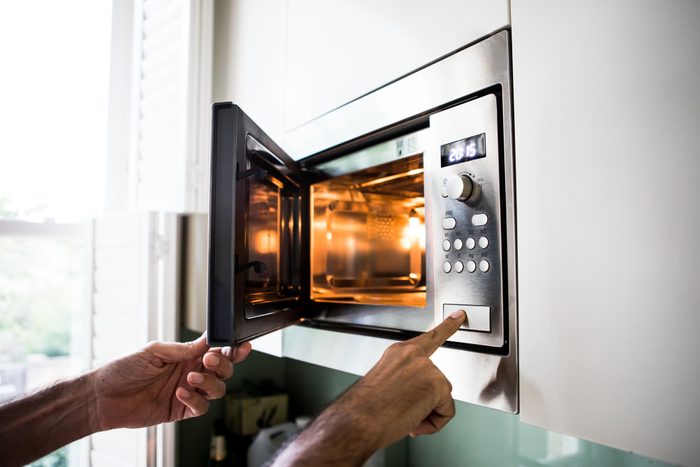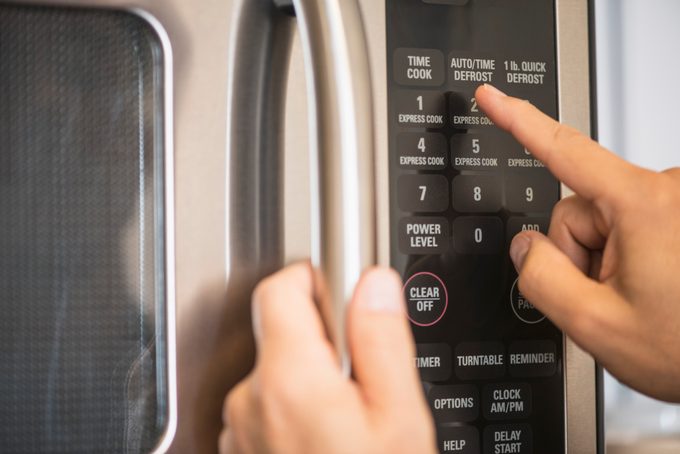Microwaves: What To Know Before You Buy
Updated: Feb. 02, 2024

Finding the perfect microwave shouldn't be complicated. Use our tips to determine which one will best fit your needs, lifestyle and budget.
Whether you’re an experienced home chef or your cooking expertise tops out at making popcorn, a microwave is an essential kitchen appliance. When it’s time to shop for a new one, consider the type and features that best suit your situation.
On This Page
How Does a Microwave Work?
When you turn on your microwave, tiny electromagnetic waves invisible to the human eye move around within the chamber and excite the water molecules in your food. These molecules move rapidly and collide, absorbing microwave radiation. As the molecules move, they cook the food. That’s how solid butter melts in a matter of seconds, and leftovers heat up in minutes.
Types of Microwaves
Which type of microwave is right for you will depend on how often you plan to use it, how important aesthetics are to you, what your budget is and what you plan to cook most often.
“When shopping for a microwave, location and use are critical,” says Jeramy Bagozzi, senior merchant in appliances for cooking and dish products at Lowe’s.
“There are countertop models from .7 cu ft to 2.2 cu ft, over-the-range models that include a range hood fan for cooking ventilation, and even new slim models that can replace existing range hoods. There are also built-in microwaves that seamlessly install into cabinetry.”
Countertop microwaves
As the most common and affordable type, countertop microwaves have a major impact on the market. They are typically compact and easy to use — just plug them in. On the downside, they take up counter space. But their lower price and portability make them worth it for most people.
Built-in microwaves
Built-in microwaves fit into the design of your kitchen. They can be placed over the range, in a wall, or in a drawer. These options save counter space and often blend in with the décor, cabinets or other appliances, adding to the aesthetic appeal of your kitchen.
These tend to be significantly pricier than countertop microwaves and more complicated to replace. But their replacement cost also makes it worth considering repairing a malfunctioning, built-in microwave. Ron Shimek, president of Mr. Appliance, a Neighborly company, says, “For microwaves, or any appliance for that matter, it’s always a good idea to look at the potential cost, time, and effort savings that come with repairing versus replacing.”
Shimek says technicians regularly repair microwaves, if it’s cheaper than ordering, shipping and install a replacement. Many appliance repair service professionals will come to your home to give estimates, following local COVID-19 mandates and best practices.
Combination microwave ovens
Sometimes a combination microwave serves as a grill, convection oven and microwave, but more often it simply doubles as a convection oven. If you have limited kitchen space, buying one appliance with multiple functions can be the good solution.
Like traditional microwaves, combinations are easy to get up and running and relatively easy to replace. However, their higher price may make repairing instead of replacing a good option.
Microwave Features

Consider these special features when weighing your microwave options. Make a list of all the features you consider essential before shopping.
Power
Wattage indicates a microwave’s power. Unless you only plan to use it occasionally, choose a microwave with at least 1,000 watts of power. Unsure if your kitchen circuits can handle the load? Shimek recommends hiring an electrician to audit your electrical system.
Size
The size of your microwave matters, especially if you have limited counter space. If you plan to cook large dishes for a family in your microwave, make sure larger microwave-safe dishes fit in the model you choose.
Presets
Common presets on a microwave are Popcorn, Fresh Vegetable, Frozen Vegetable, Potato, Beverage, Defrost, Soften/Melt and Reheat. These will vary by brand and microwave.
Turntable
It’s always a good idea to choose a microwave with a turntable, so the food rotates and heat evenly. Otherwise, you’ll have to stop cooking and turn the food by hand.
Two-stage cooking option
This is a good option if you’re cooking food straight out of the freezer. These models defrost the food, then automatically switch to the regular cooking mode.
Smart sensors
More new microwaves feature smart sensors that help prevent over-cooking your food. If you are not experienced with microwaving food or are experimenting with new dishes, this can be an especially useful.
Microwave Maintenance
If you take good care of your microwave, expect to enjoy it for approximately five to 10 years. Follow these tips to improve the lifespan and keep your microwave in good working order.
- Use only microwave-safe containers. Not all plastic food containers should be used in the microwave. Some can even harm your microwave and release toxins into your food. Truly microwave-safe food containers will be marked that way on their packaging.
- Keep all metallic containers and utensils out of the microwave. Metallic items should never be microwaved. They can cause sparks and even a fire if left unattended.
- Cover all food and beverages. Don’t heat anything in the microwave without covering it up. Otherwise, you’ll risk messy splatters and possibly damage your microwave.
- Be gentle with your microwave door. Avoid slamming the door or shutting it quickly with your elbow. Microwave latches are surprisingly complex and can be easily damaged. Take the time to set down what you’ve cooked and gently close the door.
- Regularly clean your microwave. Clean the inside and the outside of your microwave every week. If you have spills or splashes, clean up the mess right away to prevent stains and damage.
